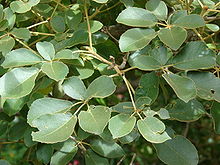- Tabebuia serratifolia
-
Tabebuia serratifolia 
Scientific classification Kingdom: Plantae (unranked): Angiosperms (unranked): Eudicots (unranked): Asterids Order: Lamiales Family: Bignoniaceae Genus: Tabebuia Species: T. serratifolia Binomial name Tabebuia serratifolia
(Vahl) Nichols.Synonyms Bignonia serratifolia Vahl
Tecoma serratifolia (Vahl) G.DonYellow Lapacho (Tabebuia serratifolia[1], also known as Yellow Poui or ipê-roxo) is a tree native to forests throughout Central and South America. This plant grows in the Cerrado vegetation of Brazil, reaching up to French Guiana, Bolivia, Paraguay and Northern Argentina. It is one of the largest and strongest of tropical forest trees, growing up to 150 feet tall while the base can be 4 to 7 feet in diameter. It is a commercially farmed hardwood notable for its extreme hardness and resistance to fire and pests. It is sometimes traded as an "ironwood" or just as "ipê" (the entire genus Tabebuia) or lapacho (properly Tabebuia serratifolia)
The bark of Tabebuia serratifolia contains more than 20 active compounds including lapachol, quercetin and other flavonoids. Its inner bark is used as a treatment for fungal infections.
References
See also
- List of plants of Cerrado vegetation of Brazil
- Guide de reconnaissance des arbres de Guyane
Categories:- Tabebuia
- Trees of Trinidad and Tobago
- Trees of French Guiana
- Trees of Guyana
- Trees of Suriname
- Trees of Venezuela
- Trees of Brazil
- Trees of Bolivia
- Trees of Colombia
- Trees of Ecuador
- Trees of Peru
- Lamiales stubs
- Tree stubs
Wikimedia Foundation. 2010.
